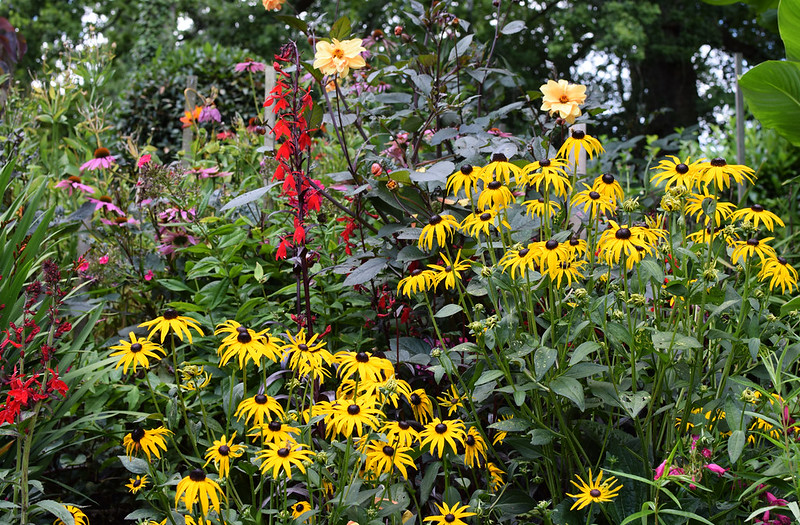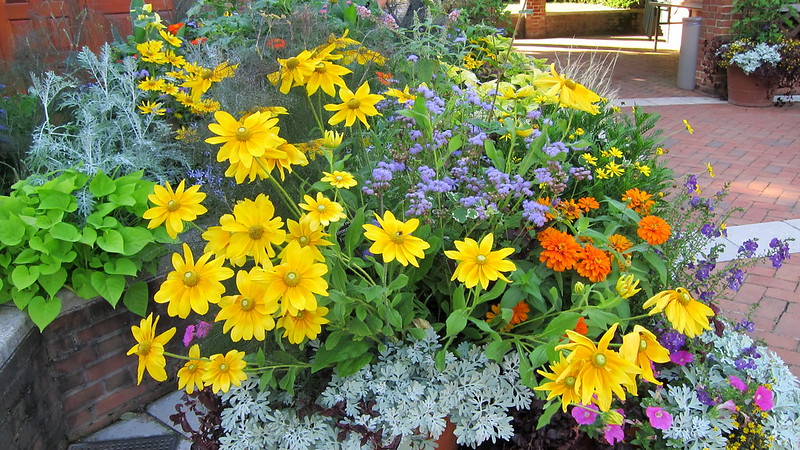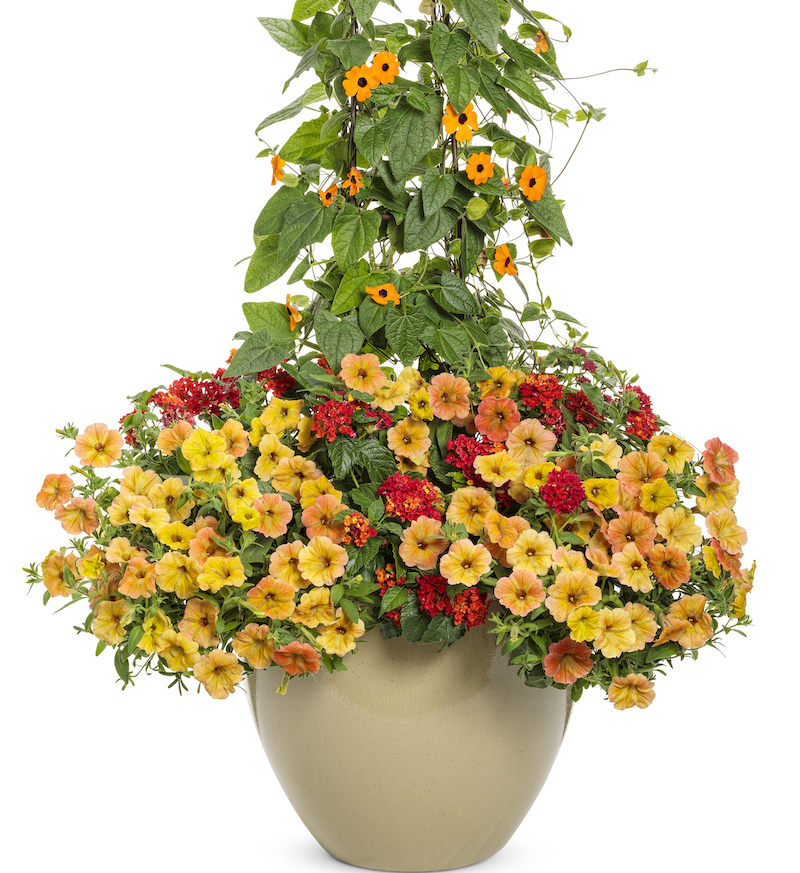Naturalistic garden design incorporates native and pollinator-friendly non-native plants to provide food, shelter, and safety for wildlife in the home garden. One of the best plants for a naturalistic plan is the perennial Black-Eyed Susan, Rudbeckia hirta. Black-Eyed Susan is hardy in most areas of the United States and Canada. This easy-to-grow plant combines readily with other native plants to create low-maintenance landscapes or brightly colored containers for your patio or deck.

Photo by Mark Wordy, unmodified, Flickr, copyright CC BY 2.0
Black-Eyed Susans need moist, free-draining soil in a location with at least 6 hours of sun a day to grow healthy and happy. This plant is not overly aggressive in the garden. It spreads by underground rhizomes and produces a moderate amount of seed at the end of the summer. Leaving the seed heads uncut will not only provide an interesting structural element in winter but also provide a food source for non-migratory birds.
Shrubs To Plant with Black-Eyed Susans
The bright sunny flowers of Black-Eyed Susans are easy to mix with already existing elements in your garden. Shrubs with brightly colored foliage or bark do a great job of providing an interesting backdrop. Red twig dogwood, choisya, elderberry, smoke bush, and barberry all bring bold color that complements the bright yellows and orange of perennial Black-Eyed Susans. Other native shrubs can be used to add layers of beneficial flowers, berries, and foliage. Snowberry, Oregon grape, mock orange, and serviceberry grow well in most locations of North America and require little seasonal maintenance.
Perennials To Plant With Black-Eyed Susans
Any perennial that can grow in well-draining soil and full sun would make a great companion plant for Black-Eyed Susans. The blue-colored flowers of globe thistle, sea holly, Russian sage, and baptisia have a cooling effect on the hot-colored Black-Eyed Susan flowers. Agastache, salvia, poppies, and yarrow are first-class plants to attract pollinators and are also available in hot colors for an intense shot of color through the summer. Joe pye weed and tall ornamental grasses provide movement when they catch even the slightest breeze and look great when placed behind lower-growing Black-Eyed Susans in a naturalistic garden.
Annuals To Plant With Black-Eyed Susans
Black-Eyed Susans are not only great for planting in perennial or shrub gardens but are a wonderful addition to a kitchen garden where they can help attract beneficial pollinators. Dill, cilantro, marigolds, cosmos, and nasturtium have a decorative look while also being edible.
Try a more refined planting of ageratum, lantana. sweet potato vine, and petunias if you need to fill in a garden bed until other plants mature. Using annuals in a garden bed allows you to mix and match colors to decide the look you want before buying large amounts of expensive perennial plants. Growing mostly annuals is also a great way for renters to dismantle their gardens when they decide to move.

Photo by K M, unmodified, Flickr, copyright CC BY 2.0
Best Companion Plants For Black-Eyed Susans in Containers
Black-eyed Susan vine (Thunbergia alata) shares its common name with Rudbeckia hirta, but is not part of the Asteraceae family. This tender, tropical vining plant is most often marketed and sold as a hot-weather ornamental annual. Black-eyed Susan vine is easy to grow and makes a striking centerpiece in a mixed seasonal container.
Plant Black-eyed Susan vine as the thriller toward the back of a large (at least 16-inch-diameter) pot. Add a support for the vine to climb, such as a trellis or teepee made from bamboo canes. Mix in lantana and supertunias in bright cheery colors to fill in the rest of the container and provide a graceful drape over the edge.

Plants Not To Grow With Black-Eyed Susans
Black-Eyed Susans will not grow well in more than 6 hours a day of shade and soil that remains soggy. Mildew and root rot diseases are more common under these conditions and difficult to treat. Avoid planting black-eyed Susans with shade or bog plants like hostas, gunnera, and cardinal flower.
Best Plants To Grow With Black-Eyed Susans
Black-Eyed Susans pair best with other sun-loving, pollinator-friendly plants. Creating a low-maintenance meadow or wildlife-friendly landscape is easy when all of the plants have the same care requirements. Select companions that appreciate well-draining, moderately fertile soil, full sun exposure, and average moisture levels. Some great choices for a native planting include elderberry, smoke bush, and agastache, which will nicely contrast black-eyed Susan blooms.
 |
Author Robbin Small - Published 9-18-2023 |




